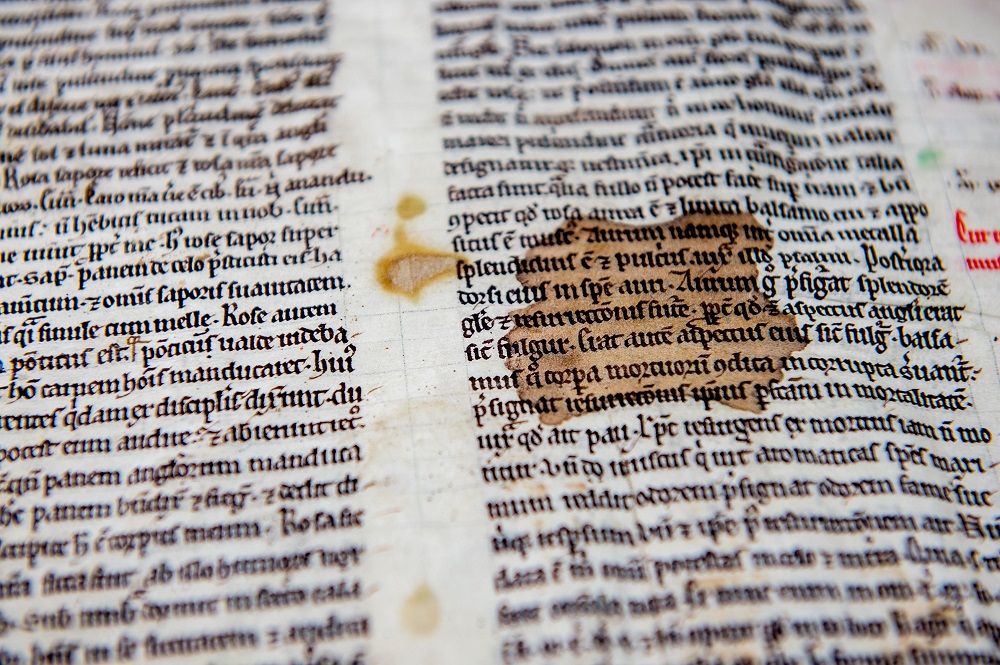13th century Monk’s Blood manuscript goes on display to celebrate Welsh university’s landmark year

A 13th century Monk’s Blood manuscript has gone on display to celebrate a landmark year for the University of Wales Trinity Saint David.
It is is part of a series of physical and online exhibitions arranged by the University’s Library staff to commemorate the Bicentenary of the foundation of St David’s College Lampeter on 12 August 1822.
Throughout the year, a series of exhibitions and seminars have been arranged to showcase the Special Collections held at the University’s Roderic Bowen Library and Archives in Lampeter.
The famous Monk’s Blood manuscript, produced around 1200, and the oldest item in the library’s collection, was said to be stained with the blood of the monks of Bangor-is-y-coed.
Although this is a myth, the work, a fragment of Peter of Capua’s Alphabetum in artem sermocinandi, is one of the earliest experiments in what is called alphabetization.
Comprising a collection of biblical extracts, the Monk’s Blood manuscript was designed to help preachers find texts for their sermons. It is one of the first experiments in arranging items in alphabetical order as a finding aid, and therefore a direct ancestor of all hard-copy dictionaries and encyclopaedias.
‘Wild Wales’
This manuscript’s greatest claim to fame is through the stains on its last few leaves. In 1870, the English writer George Borrow described his visit to Lampeter in his book ‘Wild Wales’.
He said: “The grand curiosity is a manuscript Codex containing a Latin synopsis of Scripture which once belonged to the monks of Bangor Is y Coed. It bears marks of blood with which it was sprinkled when the monks were massacred by the heathen Saxons, at the instigation of Austin, the Pope’s missionary in Britain.”
The above story is chronologically impossible. The massacre is said to have happened in the early 7th century; but this manuscript cannot be earlier than the late 12th century. Although they resemble blood, the stains on the manuscript could equally be wine.
Ruth Gooding, Special Collections Librarian said: “This volume, probably dating from the reign of either Richard I or John, is almost certainly the most famous item in our collections, as well as the oldest. These collections are undeniably a treasure, not only for the university but also for Wales.”
“They comprise more than 30,000 volumes printed between 1470 and 1850 as well as eight medieval and 100 post-medieval manuscripts.”
Support our Nation today
For the price of a cup of coffee a month you can help us create an independent, not-for-profit, national news service for the people of Wales, by the people of Wales.





Why do they date the book in relation to an English king and not the rulers of Cymru. This speaks volumes about the automatic relationship with English as the only history.
⬆️ 100% agree – and if the argument is, ‘people wouldn’t know who the Welsh rulers were’ educate us/them!
This is a fine example of a medieval Welsh manuscript that thankfully wasn’t stolen by English incursions into Wales.
Sadly not all of our literary treasures had a similar fate. The Gospels of Chad that holds the oldest written Welsh was stolen and now resides at Litchfield Cathedral and the Red Book of Hergest that contains tales from the Mabinogi is now at Bodleian Library at Oxford University like many other nations treasures stolen.
After the Welsh monks, who had been Christian since the first century, refused to bend the knee to Austine, who had blatantly disrespected them, he ordered their slaughter.The Welsh monks had also refused to attempt to civilize the Saxon’s, (why should they since they were butchering the Cymru). The native religion was not based on social control power and wealth, like the new Roman version, so the Welsh saw it as alien and corrupt. The, ‘ venerable’, Bede relished this slaughter, using language that would be regarded as racist today. Bede by the way, never left his own village and… Read more »